Sunday, 17 July 2011
Distance 23 km
Duration 4 hours 45 minutes
Ascent 103 m, descent 117 m
Map 133 of the TOP100 lime-green series
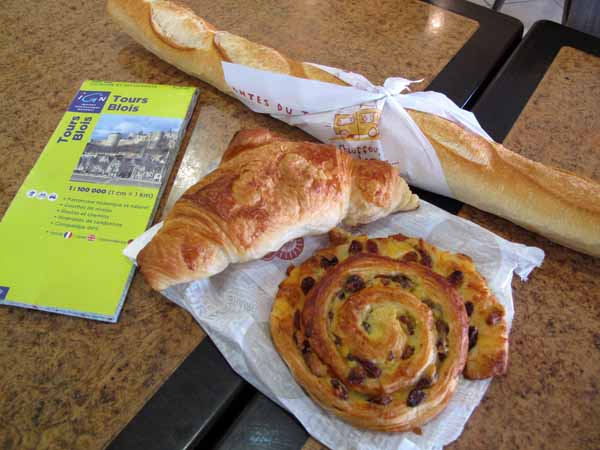
Whilst scouting about in Bléré the previous evening in search of dinner, we had asked at various bars about the possibility of an early coffee, but the answers had not been encouraging. Most of them seemed to be opening at 9 or even 10 o’clock, far too late for us, but we decided to go into town at 8 am, buy some bread and pastries and hope for the best.
So it was that we found ourselves comfortably installed in the bar next to the boulangerie at 8:15, contemplating hot milky coffees and pastries still warm from the oven. It was a promising start to our last full day on the hoof, a considerable improvement on yesterday, when we walked for half an hour on an empty stomach before breakfast.
The church square and the little street curving down to the river were empty, as if rinsed clean by the rain. We resumed our riverside walk on the GR41, through patches of woodland separated by fields of sunflowers and wheat.

In a forest glade we were surprised to see two walkers approaching, who turned out to be from the nearby village of Azay-sur-Cher, out for a Sunday morning stroll.
They were even more surprised to see us, with our serious packs and boots and our foreign accents and our tale of walking for three weeks or more. They told us that the village had a bar but they were not sure whether it would be open.
Soon after that we came to the water-mill of Nitray, whose walls were all cloaked in thick green creeper. The river had been held back by a weir and diverted through a wheel-race behind the building, which was thus on a man-made island. The mill was probably not operating these days, but it looked capable of it.
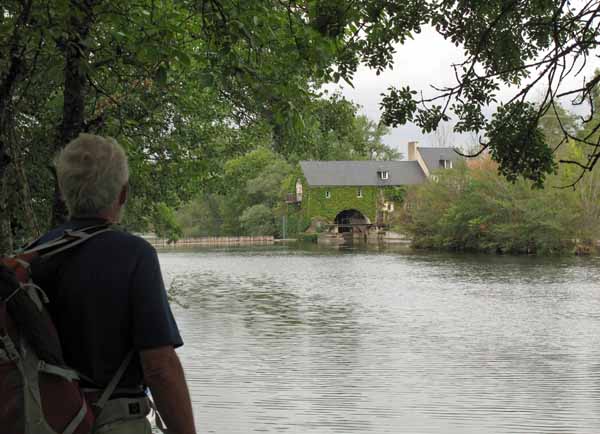
Beyond that, our path took us behind the château of Leugny, a modest place by the standards of this part of France (where royal palaces are thick on the ground), then past a fine pigeonnier and into the village of Azay-sur-Cher, where there was a bridge.
The village itself was high on a steep promontory and we hoped, as we puffed up the street, that we would be suitably rewarded with coffee at the top. We need not have worried – the tiny bar was doing a great trade and we could hardly get in the door.
A group of local fishermen were occupying a large table in the centre of the room, drinking wine, eating sausage and discoursing loudly.
Meanwhile the barwoman, a raddled blonde, stood smoking in the open doorway between the bar and her private quarters, abiding by the letter of the new anti-smoking law, although the smoke drifted in over her customers.
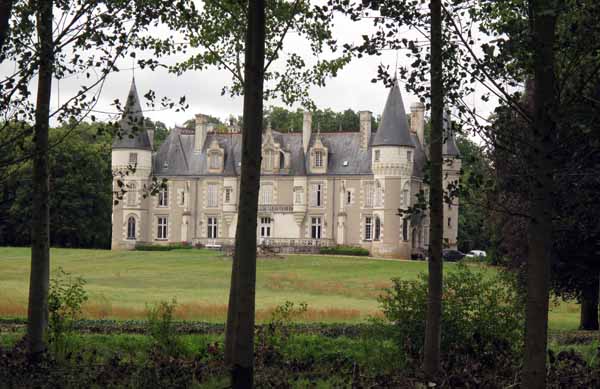
We had a delightful coffee with chunks of our fresh bread and some saved-up butter from the dinner at Montrichard. As we were leaving, one of the fisherman commented that my hat was very silly, as it would blow away in the first puff of wind. I showed him the cord that held it on and we all laughed.
Back on the GR, it was only a short distance to the bigger village of Véretz, which sprawled low beside the river. There was a camping ground, rather deserted, and a couple of bars, but we decided to keep going to St-Avertin. The GR crossed the bridge and continued on the right bank, but we could see from the map that we would not be able to cross back until we had gone past our destination. Anyway, we were a bit bored with the riverside path.

The alternative along the road was not very edifying, but at least it was direct. Almost immediately we entered the built-up outskirts of the agglomeration of Tours, which gave us something to look at – mostly architectural mistakes of one kind or another.
The Sunday traffic was light and the weather cool, so we made quick progress and soon came to a large, beautiful public garden surrounding a serpentine lake with islands, and the camping ground of St-Avertin was on one of these islands, separated from the Cher by a levee bank and reached by a small bridge.
It had an ominously deserted look as we came in the gate and the reception door was locked. We saw a shower block further on and went to see whether there was hot water – a good test of whether a place was operating or not.
In this case the result was ambiguous, as the water came out faintly warm. Just then a cleaning woman emerged from somewhere and told us that the reception was open, so we went back and tried again.
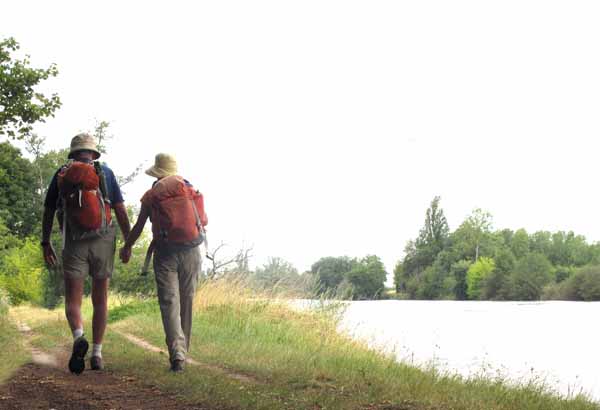
This time the door opened and there was a man at the desk, looking as though he had been there for hours. He advised us to use the new ablution block, not the one we had just been to (thus saving us from three tepid showers in a row).
As to finding a meal tonight, he recommended a restaurant, le Faisan, in the village, or failing that, the shopping centre across the river.
As it was already nearly 2 pm, we had lunch straight away, sitting on a bedroll in our hedged enclosure. There were actually quite a number of other campers about but they had been hidden in the greenery.
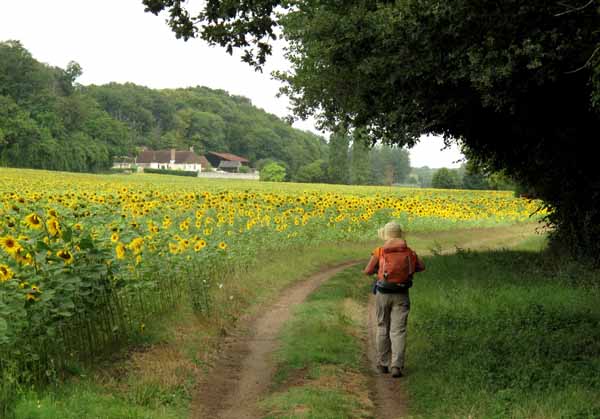
The new showers were splendidly hot, copious and adjustable and I stayed there a long time, washing my socks, undies and shirt as usual and wishing that I could do the same for my blue jacket, which stank of sweat, and my long trousers, which were covered with grime and grease-spots.
However I could not afford to, as it was so cold that I would need to wear them that evening and I could never get them dry in time, the weather having deteriorated to rain.
We lay in our tent reading, with the rain pattering on the roof, consoling ourselves with the thought that we would be in a hotel in Tours by tomorrow.
Late in the afternoon, when the rain stopped, we went for a walk into the centre of St-Avertin, which was a fine-looking little place but completely dead, with all three bars and the restaurant closed.
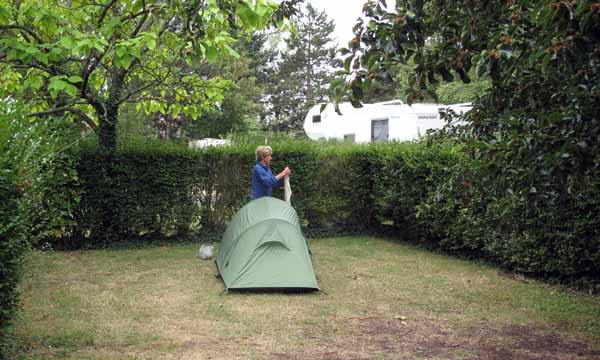
On the way back we took the long route around the gardens along the prosperous Quai Carnot, past a row of houses with an enviable view over the lake. Just opposite the camping ground was the charming Bistro du Lac, with its terrace jutting out into the quiet water, but it was closed on Sundays.
As a last resort, we decided to try the shopping centre across the river that our host had mentioned, although we were not hopeful. It was raining again and the wind had come up, so we struggled along the levee bank in our plastic capes, crossed the Pont d’Arcole and found ourselves in a fearsome futuristic landscape where all the buildings were ten times bigger than normal, set in acres of deserted bitumen.

We expected at any moment to see a twenty-metre-high giant emerge from one of the entrances. The roads were all highways, flyovers, autoroutes or enormous roundabouts. Past a gargantuan Ikea, under a multi-lane highway and across an ocean of empty carpark, we came at last to the shopping centre.
It was closed and shuttered except for one door, and this led into a pair of functioning eateries, one a Flunch (selling crèpes, pastries and sandwiches), the other an Italian restaurant. As soon as we went in, we knew we were saved.
It was large, lamp-lit and welcoming, with a mural of an Italian village taking up all of one wall. A dozen or more tables were already occupied and we gratefully took another.
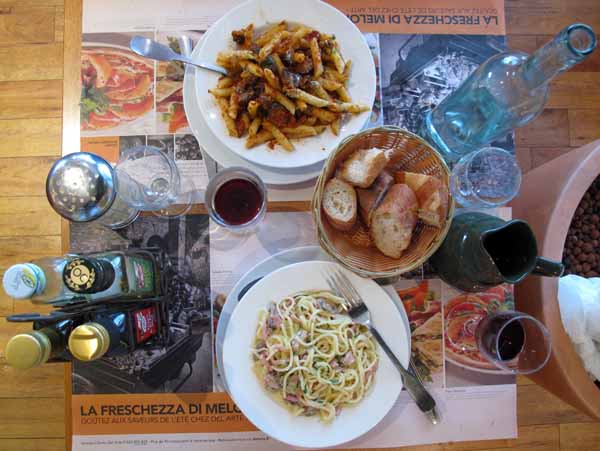
We were in no hurry, so we had apéritifs before ordering, enjoying the warmth, shelter and company that we had so unexpectedly found. Then we had the €13.50 menu, which included wine.
First courses were a rocket salad with shaved parmesan, and a tomato and mozzarella salad, which we shared. For mains we had spaghetti alla boscaiola (Keith) and penne ai legumi (me).
Hurrying home in the cold wind, we felt full, not only of food, but of love for our fellow man, who had provided us with such a surprising treat on such an inauspicious evening.
Previous day: Montrichard to Bléré